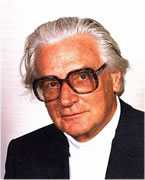Prof.Dr.E.h.mult.
Konrad Zuse
Born: 22 June 1910 in Berlin-Wilmersdorf
Died: 18 December 1995 in Hünfeld
"A researcher needs to believe in a certain idea for pursuing his work. Without this belief he would be lost in a sea of doubts and partial evidence."
Zuse abandoned his employment as a structural engineer in 1936 in order to pursue his vision of a programmable machine.
Calculating machine and digital computer
After graduating in civil engineering, Zuse worked as a structural engineer with Henschel aircraft company until 1935. Being "lazy", and having a dislike for time-consuming structural calculations, as he once admitted, he started to assemble a program-controlled calculating machine functioning on a mechanical basis. The installation grew in his parents' living room, eventually covering four square meters.
The mechanical calculating machine, type Z1, was completed in 1938. Due to unreliable components, it did not function properly.
In 1940, Zuse founded Zuse Apparatebau Berlin, one of the first IT companies. In the following years he developed Z3, a fully operational program-controlled electromechanical digital computer. At that time, he also created the programming language "Plankalkül".
For some time the Z4 model, completed in 1945, was considered to be the only functioning computer in Europe. It was utilised at the university of Zurich and helped scientists with theoretical studies in the field of Boolean algebra and computer algorithms. Series production started in 1955. The machines were used in Germany and abroad.
Plankalkül language
Between 1942 and 1945, Zuse developed Plankalkül, which today's experts consider to be the first higher programming language.
According to Professor Rojas of FU Berlin university, Plankalkül works with variables representing different structures, recognises the assignment, the conditional branching and loops (source: FU Berlin university press service, communication 36/2000).
For a long time, only a written draft of the programming language was available. Only recently, computer scientists have built a compiler allowing to write programmes in this language, running on the computer. This was the fulfilment of Zuse's hope that he had mentioned in a lecture given in 1957: to see Plankalkül finally come to life.
Copies
Zuse built a copy of Z1 that is on display at the Museum für Technik und Verkehr in Berlin. A copy of Z3 is displayed at the Deutsches Museum in Munich. Z4, the second general-purpose electronic computing facility, is the only original that has been preserved.
After Zuse AG of Bad Hersfeld had been taken over by Siemens AG, Zuse focused again on research. He was honorary professor and lecturer at the university of Göttingen and painted under the pseudonym of Kuno See.
Patent search
To find out more about Konrad Zuse's patents, go to DEPATISnet

© H. Zuse
patent document DE-975966
"Rechenmaschine zur Durchführung von arithmetischen Rechenoperationen"
(PDF - 1,38 MB)
Barényi . Binnig . Bölkow . Bruch . Dethloff . Fischer . Hell . Lindenmeier . Oberth . v.Ohain . Peter . Quadbeck-Seeger . Ruska . Sauer . Wankel . Winnacker . Zuse
Copyright © Deutsches Patent- und Markenamt 2004
